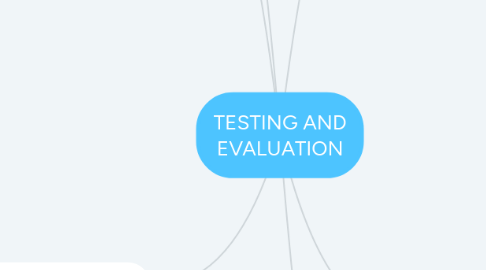
1. SUMMATIVE AND FORMATIVE ASSESMENT
1.1. Summative
1.1.1. Related to give a score or grade
1.2. Formative
1.2.1. Directed to the continuos process and doesn't have a score
2. QUALITIES OF A GOOD TEST
2.1. Washback
2.1.1. Effect of test on students
2.2. Transparency
2.2.1. Everybody has clear statements about what is measure
2.3. Validity
2.3.1. Measures what is supposed to be measured
2.3.1.1. construct
2.3.1.1.1. Gives picture of what is going to be evaluated
2.3.1.2. content
2.3.1.2.1. Corresponds to what is supposed to be evaluated
2.3.1.3. criterion
2.3.1.3.1. produces similar results no matter the evaluator
2.3.1.4. Face
2.3.1.4.1. Has the look of a balanced and accurate test
2.4. Reliability
2.4.1. Consistency of the results
3. TYPES OF TEST
3.1. Progress and achievement
3.1.1. measures skills according to the syllabus
3.2. Proficiency
3.2.1. general view of students production and comprehension
3.3. Portfolio assessment
3.3.1. Evaluating the best works done during the term
3.4. Placement
3.4.1. To decide a group to attend to
4. TEST ITEM TYPES
4.1. Typical test item types
4.1.1. Multiple-choice questions
4.1.1.1. Difficult to write well
4.1.1.2. May not always lead to improve their level of language
4.1.2. Gaps fill
4.1.2.1. Make knowledgeable how many words are possible and expected
4.1.3. Summarising
4.1.3.1. evaluates the ability to understand and put understanding in words
4.1.4. Transformation and paraphrase
4.1.4.1. Rewrite retaining the same meaning or information
4.1.5. Reordering
4.1.5.1. measures the underlying knowledge of syntax
4.2. Young learner test item types
4.2.1. Pictures
4.2.2. Dragging, Dropping, and clicking
4.2.3. Ticks, crosses, and smiley faces
4.3. Skill-focused test
4.3.1. Needs to give the chance to students to reach the same level of success
4.3.2. Needs to avoid making excessive demands on general and specific knowledge
5. WRITING AND MARKING TESTS
5.1. Marking test
5.1.1. Human graders
5.1.1.1. Oral exams
5.1.1.1.1. Scoring and interacting
5.1.1.2. Has risks as being subjective
5.1.1.2.1. Has the solution to turn reliable
5.1.2. Digital graders
5.1.2.1. Noticed as reliable and more efficient
5.2. Writing tests
5.2.1. its important to to have clear
5.2.1.1. Objectives
5.2.1.1.1. Why are doing this test?
5.2.1.2. future action
5.2.1.2.1. What are we going to do with the results?
5.2.1.3. context
5.2.1.3.1. How long? when and where will it be done?
5.2.2. Test content
5.2.2.1. what do we want?
5.2.3. balance
5.2.3.1. how many may be included?
5.2.4. scoring
5.2.4.1. how many marks will be given?
5.2.5. Trialling tests
5.2.5.1. Is it according to the level I want to apply it?
6. TEACHING FOR TEST
6.1. The expectations (of parents and students) could affect the results (washback)
6.1.1. Discuss general exam skills
6.1.2. Train for test's rubrics
6.2. It's satisfying for some teacher because it helps students to focus on a goal and contributes to autonomous learning
6.2.1. Do practice tests
6.3. It's important to focus en the main goal (lead students to pass the test) and make it fun for the students
6.3.1. Have fun
